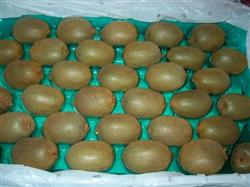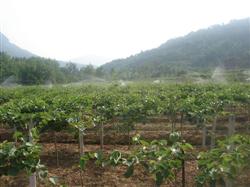Key points of kiwifruit planting

Rich in a variety of vitamins and nutrients, known as the "king of fruit", has high economic value and cultivation value. It is suitable to be planted in mild climate, abundant rainfall, fertile soil, lush vegetation, deep, well-drained, moderately moist black humus soil, sandy loam and slightly acidic soil with pH 5.5-7. 1. The suitable varieties are Hongyang (Hongyang), Heywater, Bruno, Qingcheng No. 1, Qinmei, Miliang No. 1, Chuanyi No. 2, Chuanyi No. 3, Chuanji No. 4 and so on. 2. Raising seedlings 1. Rootstock seedlings are cultivated to collect fully ripe fruits from the first and middle of September to October. After ripening and softening, squeeze the fruit together with the seeds, rub them in a gauze bag, separate the seeds from the pulp, then rinse repeatedly with clean water, and spread the washed seeds indoors to dry. Soak the seeds in 40-50 ℃ warm water for 2 hours, then soak in cold water for one day and night, and then sow the seeds in sand for 50-60 days. Kiwifruit seeds are afraid of dry and wet in the process of sand storage, so they should be checked and turned frequently to prevent mildew. The sowing time is generally ideal from mid-March to early April. One is to choose the nursery where the soil layer is deep and fertile and where the drainage, irrigation and transportation conditions are good; the other is to prepare the soil, apply sufficient base fertilizer, remove sundries, the width of the nursery is about 1 meter, slightly suppress the nursery bed, pour water through it, and sow the seeds of sand storage with sand. After sowing, sprinkle a layer of fine river sand about 2-3 mm thick and cover with straw, spray water on the straw or build a plastic shed (11280,-35.00,-0.31%). The third is to strengthen the seedbed management to ensure the cultivation of robust rootstock seedlings. 2. The suitable grafting period for grafted seedlings is about 20 days before germination, mainly by single bud cutting and other methods. The scion with full growth and small pith is selected, and the branch with a bud is cut, which is 3-4 cm long. Choose the straight side to cut off the skin, the cutting surface is 2-3 cm long, the depth is to expose the xylem or slightly with xylem, and the reverse side of the cutting side is cut to a short oblique surface of about 50 degrees. Cut the rootstock at 10-15 cm above the ground, select a smooth downward cut, the length of the cutting surface is slightly longer than the cutting surface of the scion, and the depth is the same as the scion, peel the rootstock 2 and 3; then insert the scion, requiring the scion to be basically the same size as the rootstock; pay attention to the layer alignment of the rootstock, and then wrap it with plastic grafting film to expose the scion bud. 3-4 weeks after grafting, the grafted buds began to sprout, and the binding film could be removed after the new shoots were basically aged. After the abdominal grafted seedlings survive in spring and autumn, cut the anvil immediately, which is about 4 cm away from the interface. After the survival of bud grafting in summer, you can first fold the anvil and then cut the anvil. Timely erasing the sprouts on the rootstock is the key to survival. The nursery should often be ploughed and weeded, and be careful not to encounter the buds that have just been sent out when weeding. After sprouting and sprouting, a pillar should be set up next to the grafting bud, and the new shoot should be tied to the pillar. The seedlings should be properly coring when they are 60 centimeters high. Combined with irrigation, human manure, pig manure, etc., or 1% urea can be added to the water, and calcium superphosphate can be added to fertilize in July to promote the aging of seedling branches and full bud eyes. Kiwifruit seedlings from July to August should take shading measures to avoid direct exposure to strong light.
- Prev

Storage technology of kiwifruit
1. Strengthen field management: The quality of fruit is the key to kiwifruit storage and preservation. Strengthen soil management, carry out formula fertilization; scientific thinning of flowers and fruits, formulate reasonable leaf and fruit ratio; protect natural enemies, strengthen pest control; scientific pruning, do not use hormones such as Daguoling, first ensure high quality and high yield,...
- Next

Key points of kiwifruit planting technology
Actinidia belongs to Actinidia genus of Actinidia family, is a deciduous vine fruit tree, rich in vitamins and nutrients, known as the "king of fruits", has high economic value and cultivation value. Suitable for mild climate, abundant rainfall, fertile soil, lush vegetation, soil to deep, good drainage, moist...
Related
- Moge, come on! The staff of the peasant association in the producing area of cantaloupe were frightened when the crowd gathered.
- Causes and Solutions of low Fruit setting rate of Apple
- Symptoms and control measures of passion fruit virus disease
- Fruit growing lesson: how do apple orchards keep high yields?
- Can you build orchards in the mountains? What are the pros and cons?
- How to manage the coloring period of Crisson grape?
- This paper introduces the processing technology of two kinds of fig products.
- How much is a month for retired teachers in rural areas by 2020?
- How can strawberry planting increase sugar content? We should pay attention to management in many aspects.
- What are the cultivation techniques on how to improve the yield of golden fruit?

